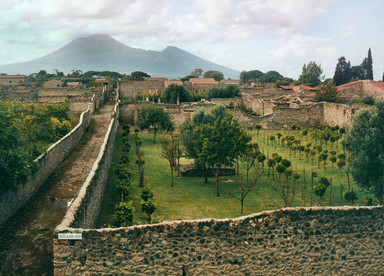
Pompeii Garden; author: Karin.
Is Noth-America inhabitable? Is there an after-life? The answer for this questions is an answer of faith.
The text of Rudofsky starts describing the amenities of modern life of the human beings, how they think that they have conquered the inconveniences of the climate, but to tell the truth, there are only pre-arranged positions, never a complete control of the weather, because it is more than the air we breathe and the temperature that we feel, it is a random series of facts. He talks about that in the time of New England Settlers, the relation between men and nature was resuming into economic advantages, transforming into a hostile environment; and that they failed to produce anything revolutionary or particularly ingenious because they retreated into their houses and all of their efforts toward maintaining a tolerable indoor temperature. And that the modern men still doing today. After a long weather talk, Rudofsky starts with his real main point: the garden. He talks about that humans do not see the garden as a potential living space, only as a space for parties; he says that domestic gardens are an essential part of the house and a ingredient for a happy environment. Rudofsky talks about how Roman gardens established a mood particularly to the most elaborate composure and they communicated a unique sense of comfort. The description of garden from Pompeii gave a better idea from what Rudofsky wanted to explain; the way of how they used the wall as an element that introduce a sense of order and its importance when they build it, because with this the human create space on human scale, he became a biped. In the final pages of the text, the main idea is about how the modern garden has become in wasted space, that front laws adds nothing to the looks of the house and that it belongs to the street rather than the house; and in this point is when Rudofsky combine the garden with the wall, explaining that the enclosing walls can be the answer to transform the garden from a wasted space into a personal space, giving the sensation of comfort and privacy that makes you feels like you have the control. Rudofsky finishes the text with the idea that you do not need pre-arranged positions in order to have the perfect control of climate, that the perfect conditioned outdoor room can be achieved with the combinations of garden and walls, that allows variations of light, temperature, humidity with the help of sun and wind; only by this way the garden will became in a living space and in a nobler version of the house. During the debate of the class and the talk with the other members that had read the lecture, there was several discussions about the main ideas of the text and in which of the 6 logics it fits; at the end we decided that the garden as an outdoor room of potential living space was the main topic, and that it belongs to a logic of system by illation and interaction, because of the relation and explanation between the climate, cultures and architectural elements with the garden. Possible topic One of the possible topic for my personal research that suggested from the reading of the text could be about how this ideas and theories can be applied in the contemporary era, the difficulties of how the garden could become into a living space because of the excess of population and the low amount of land in the world, the fight between economical facts and social convenience; inserting several new concepts like transversality actions, entropy systems, resilience spaces and optimization of resources into this ideas, the conditioned outdoor room could be a real fact for everybody and for the sake of the finite resources.